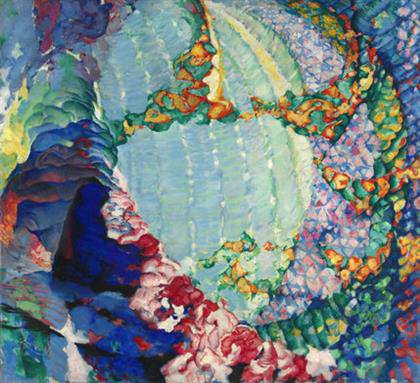
Exhibition view
© Schirn Kunsthalle Frankfurt, 2015
Photo: Norbert Miguletz

František Kupka
Printemps cosmique I (Cosmic Spring I), 1913/14
Oil on canvas, 115 x 125 cm
Photograph © National Gallery in Prague 2014
VG Bild-Kunst Bonn, 2015
“Artists and Prophets” at the Schirn Kunsthalle ‘Artists and Prophets. A Secret History of Modern Art 1872–1972’: the Schirn Kunsthalle Frankfurt presents an in-depth appraisal of a long, yet largely unknown chapter in the history of European – and most notably German – art. 6 March – 14 June 2015.]]>
Source: Schirn Kunsthalle Frankfurt
Featuring over 400 works and accompanying exhibits, including paintings, drawings, lithographs as well as extensive and rare documentary material, the show reveals astonishing causal relationships between artists of the modern period and self-styled “prophets“. The exhibition embeds these artists and prophets in a broad socio-historical context that spans a period of 100 years. Featuring unique and rarely exhibited works by such artists as František Kupka, Egon Schiele, Johannes Baader, Heinrich Vogeler, Friedrich Schröder-Sonnenstern, Friedensreich Hundertwasser, Joseph Beuys, and Jörg Immendorff on loan from the National Gallery in Prague, the Leopold Museum in Vienna, the Centre Pompidou in Paris, the Hundertwasser Stiftung in Vienna, the Kunsthaus Zürich, the Staatliche Museen zu Berlin as well as numerous private foundations and collectors, the presentation at the Schirn is the highlight of the 2015 spring exhibition season.
The starting point for the exhibition is the birth of a movement of artist-prophets in the German-speaking region around 1872. The protagonists were regarded not only as religious dissenters, but also as social revolutionaries. Their real aim was to bring about a change in the lifestyles and perspectives of their fellow human beings in hopes of empowering them to overcome individual, social, and economic problems. The best known of these artist-prophets were Karl Wilhelm Diefenbach, Gusto Gräser, Gustav Nagel, Friedrich Muck-Lamberty, and Ludwig Christian Haeusser. Each of them possessed considerable charisma and felt called upon to disseminate his revelations to the people, not for purposes of material gain, but for their own good. Although the first three of these men lived on the fringes of society in their time, Muck-Lamberty and Haeusser, who were Gräser’s disciples, attracted huge flocks of followers in the 1920s—until the National Socialists took power. By that time, all five prophets had attained legendary status. That they are scarcely remembered today is largely attributable to the fact that little attention has been paid to the irrational in German-speaking Europe since the Enlightenment. Yet these charismatic leading figures were not only well-known in avant-garde circles, but also had a profound impact on modern art in Europe. The path-breaking abstract art of a František Kupka, for example, can be traced to his contact with Diefenbach and his disciples. Much the same can be said of one of the great themes in the art of Egon Schiele: the artist as prophet. Since 1905, Johannes Baader’s Dadaist actions and collages were closely linked with his self-image as a modern-day Christ—a standpoint and position that was encouraged by Nagel, the “Apostle of Jesus.”
The subversive drawings executed by Friedrich Schröder-Sonnenstern after 1945 were inspired by his lesser-known activities as a prophet during the Weimar Republic. In the 1950s, Friedensreich Hundertwasser positioned himself as an artist-environmentalist, wandered to the most distant corners of the world, and created works of penetrating, holistic radiance for a broad public. The messianic character of Joseph Beuys’s artistic mission was also sustained by principles espoused by the prophets. And Jörg Immendorff was encouraged by them to take his “LIDL” art to the streets of Düsseldorf and profess his belief in the religion of communism.
Related content
‘Poetry of the Metropolis. The Affichistes’ at the Schirn (exhibition, 2015)
Follow us on:


